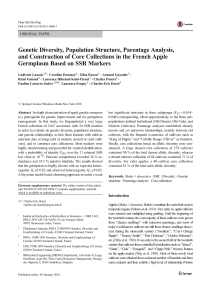Lassois L., Denancé C., Ravon E., Guyader A., Guisnel R., Hibrand-Saint-Oyant L., Poncet C., Lasserre-Zuber P., Feugey L., Durel C.E.
In-depth characterization of apple genetic resources is a prerequisite for genetic improvement and for germplasm management. In this study, we fingerprinted a very large French collection of 2163 accessions with 24 SSR markers in order to evaluate its genetic diversity, population structure, and genetic relationships, to link these features with cultivar selection date or usage (old or modern, dessert or cider cultivars), and to construct core collections. Most markers were highly discriminating and powerful for varietal identification, with a probability of identity P(ID) over the 21 retained SSR loci close to 10−28. Pairwise comparisons revealed 34 % redundancy and 18.5 % putative triploids. The results showed that the germplasm is highly diverse with an expected heterozygosity. He of 0.82 and observed heterozygosity Ho of 0.83. A Bayesian model-based clustering approach revealed a weak but significant structure in three subgroups (FST = 0.014–0.048) corresponding, albeit approximately, to the three subpopulations defined beforehand (Old Dessert, Old Cider, and Modern Cultivars). Parentage analyses established already known and yet unknown relationships, notably between old cultivars, with the frequent occurrence of cultivars such as BKing of Pippin^ and BCalville Rouge d’Hiver^ as founders. Finally, core collections based on allelic diversity were constructed. A large dessert core collection of 278 cultivars contained 90 % of the total dessert allelic diversity, whereas a dessert subcore collection of 48 cultivars contained 71 % of diversity. For cider apples, a 48-cultivar core collection contained 83 % of the total cider allelic diversity.
Consultez la notice complète de l’article sur ORBi

